CONDO NY: How to Call the Spirits
Galería Agustina Ferreyra is proud to present How to Call the Spirits, a summer exhibition for Condo, NY with works by Ramiro Chaves, Yann Gertsberger, Heather Guertin, Michael Linares, Beatriz Santiago Muñoz & Zadie Xa.
The exhibition focuses on the future, more specifically, on the power we have of transforming it through symbolic actions, whether these come in the form of gestures, objects, practices, or beliefs; the time and energy we invest in the symbolic, ultimately becomes a powerful tool to modify the course of what’s to come.
The work of Heather Guertin uses language in writing and performance, to reveal characters in the process of transformation. These creative practices inform the artist’s ongoing interest in the construction of the self. Within historical structures, such as narrative, comedy, and minimalism, she produces small deviations in form. The strange and personal exists in harmony with the universal. For the exhibition, Guertin will be reciting an excerpt of a book she is currently working on while creating a work of art, a painting that inhabits the exhibition as a receptor waiting for a story, a message. All the elements present in the selected works, synthesize and combine two types of communication, visual and aural, into one performance.
Through sculpture and textile work, Yann Gerstberger’s practice uses craftsmanship as an image making technique. A French artist living in Mexico City since 2012, Gertsberger has been producing a series of tapestries developing narratives inspired by patterns found in Mexican and African culture, art history and nature. Swiss Swatchin’ , the work included in the exhibition, blends african ritual imagery with Yoruba religion references and Nigerian Folk. The works are produced using an original technique conceived by the artist, in which he glues fibers of cotton (mops, originally) on repurposed vinyl to create naïve patterns and compositions that he then mixes with industrial utility fabrics found in markets around the city. The cotton fibers are dyed by hand, using a mixture of natural mexican dyes such as cochineal, and industrial ones like Citocol. The result is vernacular vocabulary that includes and references anything from Jodorowsky’s Fábulas Pánicas, to the European fantasy of the tropical, postgraffiti mark making, techno music, pagan rituals, and the history of abstraction with its repertoire of ambiguous and mystical shapes.
Michael Linares’s piece Unidentified Oracle is a source of answers; an artifact that contains a series of powerful elements, including enemy repelling amulets, and a five thousand year old prehistoric thunderstone found by the artist on a recent archaeological excavation. The oracle helps the spectator find the answers to whichever question they might have at any given moment. In order to activate it, ones needs to believe first, then think about the question and wait for the answer that will, eventually, come to you. As an object of art, the piece works as evidence of the human attempt to materialize the intangible, through the manipulation and modification of the auratic qualities of matter. The specificity of the elements that constitute the oracle, reveals a material eloquence that’s impossible to convey through words and can only be understood through the symbolic.
We Came Over Water is a collaboration between artists Zadie Xa and Benito Mayor Vallejo inspired by Xa’s interest in Korean shamanism and personal rituals. Set within the fictional narrative of Xa’s recent performance work “Crash, Boom, Hisssssss. Legend of the Liquid Sword”, the shoes operate as magical accoutrements for an imagined alter ego, through which the possession of supernatural abilities is enabled when worn on the body. Within the gallery presentation, short grain rice, glass marbles and conch shell fragments (collected from Jeju Island on the artist’ recent research trip to Korea) fill the empty boots highlighting a personal ceremonial protocol held before each ritual and performance begins. These three components are objects of good luck within Xa’s imagined world. We Came Over Water functions as an “elevating plinth” for Xa’s performing body while adding to the identity and character of the fictional figure portrayed. The main themes explored within the performance include the interrogation of authentic versus inherited positions and displacement within the Asian diaspora.
Photography is a starting point in Ramiro Chaves’s work, but always as a critical medium used to explore the image as a construct of time and history. His intention is to examine the possibilities that the expansion/contraction of the photographic image can have towards other disciplines such as drawing, painting, sculpture, and editorial work, among others. Chaves’s practice departs from a personal methodology in which the accumulation and appropriation of information and objects, products of investigations and documentary and autobiographical practices, come together and make sense while unfolding in parallel ways re-signified in a new idiosyncratic language. The drawings included in the exhibition are part of a larger, unfolding body of work that the artist calls El Fenómeno Manimas (The Manimas Phenomenon) in which diverse imaginaries related to infancy, animals, architecture, and mysticism are intertwined and combined into loose exercises that integrate his interest in certain structures, both formal and symbolic, such as history, memory, identity and the idea of modernity through the legacy of Latin American Architecture.
In Beatriz Santiago Muñoz’s Ojos para mis Enemigos, Pedro Ortiz Pedraza prays to the Orishas. “Give eyes to my enemies, so that they may not take mine out”. This is not a ruin and there is no nostalgia, no melancholy for a different future. The cotton trees have returned, from a time before the US Navy base was here, from an even more brutal past. Now they are taller, stronger. The cotton in Pedro’s hands is for Obatalá, an Orisha who loves the color white. Nature which is outside of all morality, is coming back. It has been 10 years since the base closed. It is a wild combination of native species, introduced species from the agricultural past, ornamental betel nut palms for the Navy’s housing. There can be no return. Packs of abandoned dogs, wild boars escaped from a farm, and native birds jockey for position. No future has been determined yet. The forest retakes acres of land every day. An infinite number of events take place.
Beatriz Santiago Muñoz
Ojos para mis enemigos, 2014
[excerpt]
HD video. Color. Sound
Rt| 14:00 minutes
Ed. of 5 + 2 A.P.

General view of the exhibition

Yann Gerstberger
Swiss Swatchin, 2017
Hand dyed cotton yarn, cochineal extract, and synthetic dyes on reclaimed vinyl.
280 x 240 cm (110 1/4 x 94 1/2 inches)
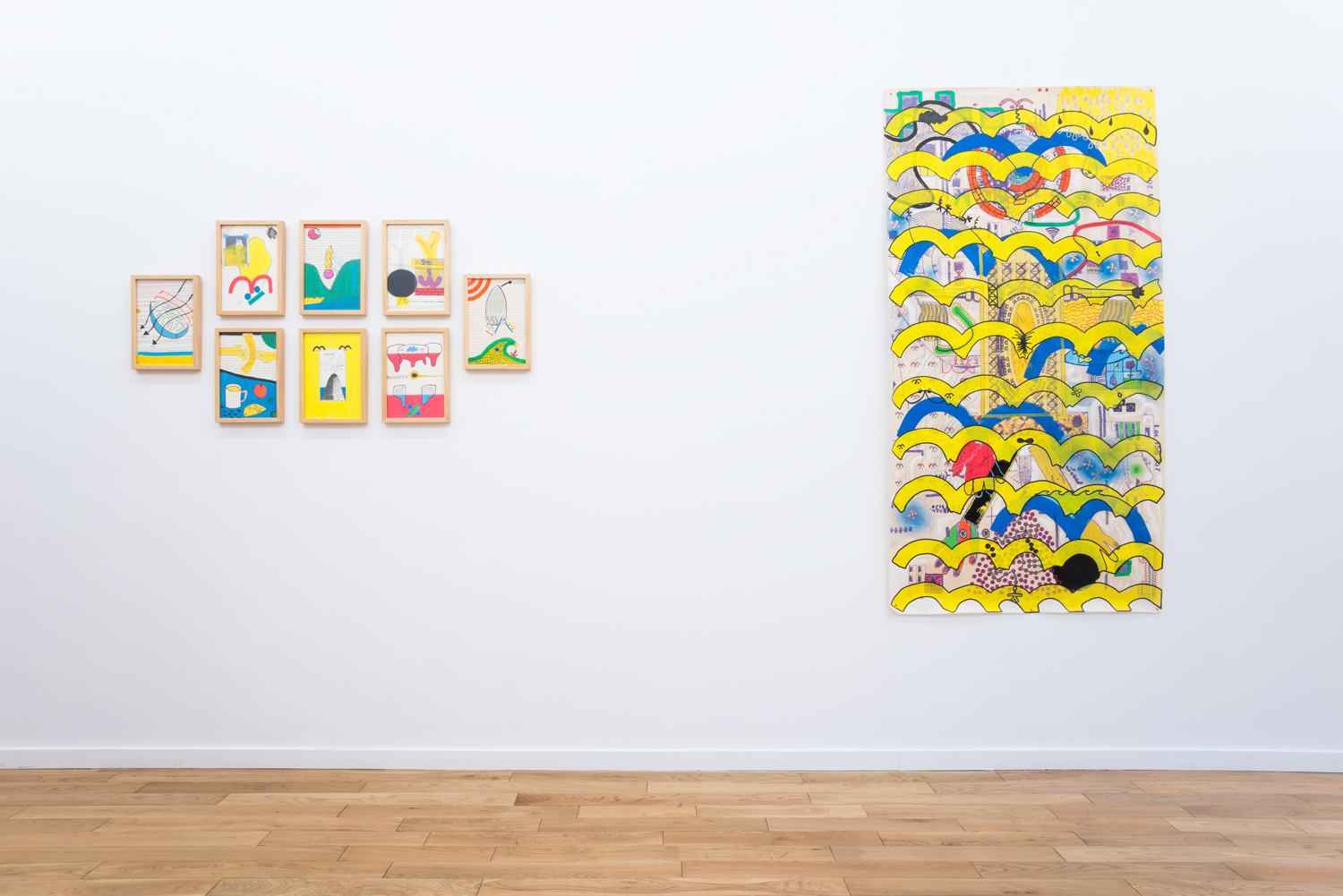
Ramiro Chaves, exhibition view.
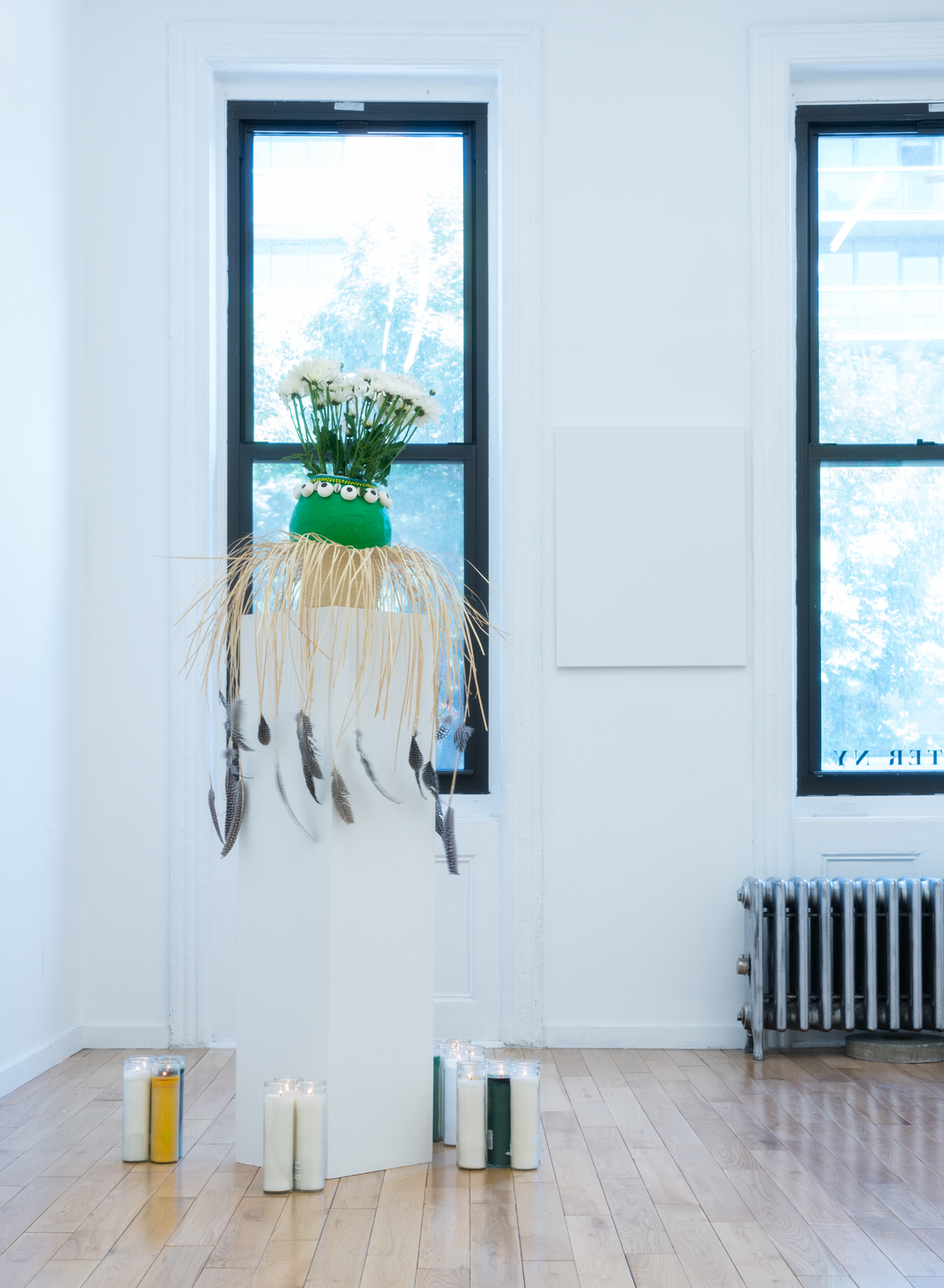
Michael Linares
Unidentifiable Oracle, 2017
White or yellow daisies, guinea chicken feathers, dried pumpkin seeds, unfinished straw hat, stone, glass, white, yellow and green santería candles.
Variable dimensions
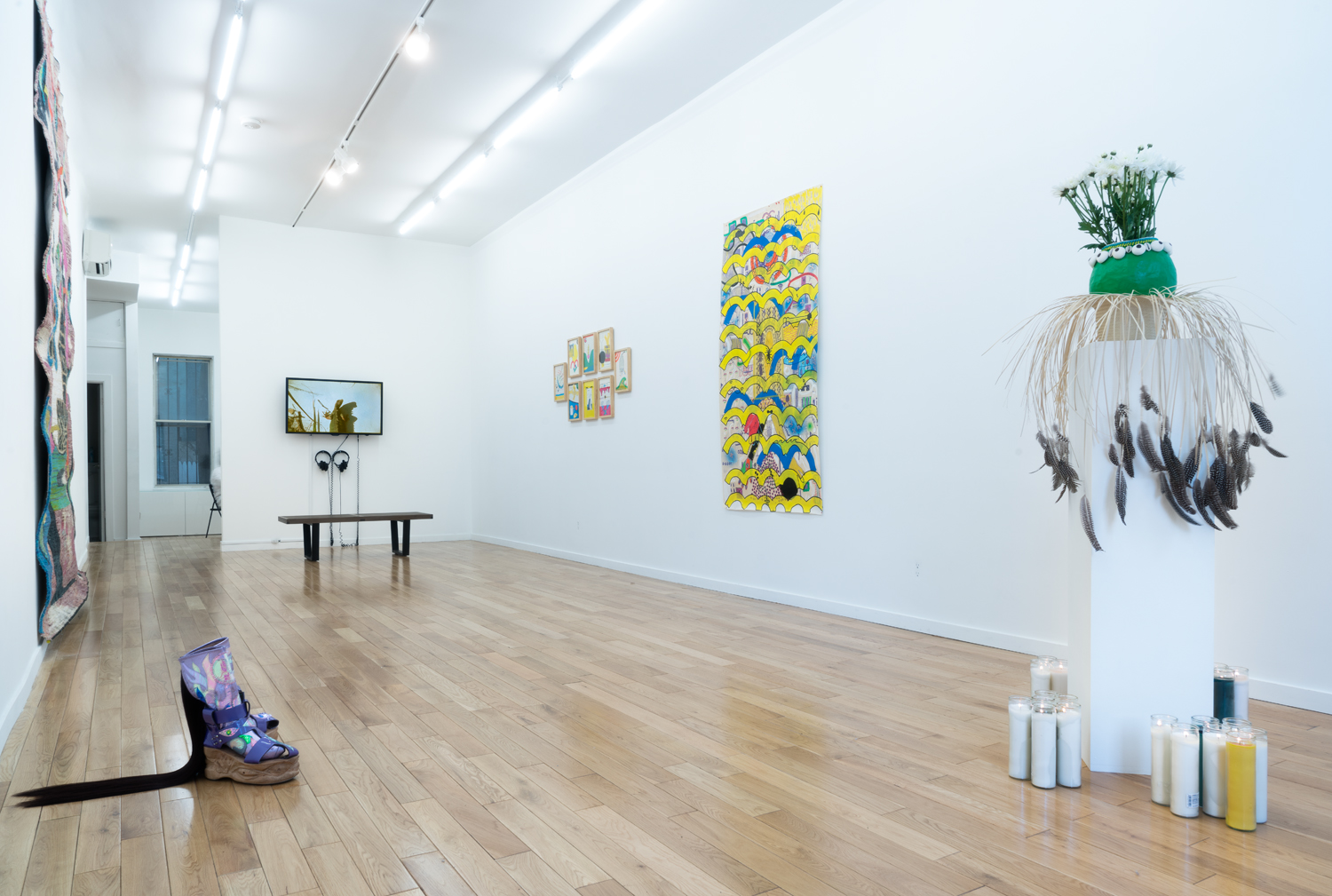
General view of the exhibition.
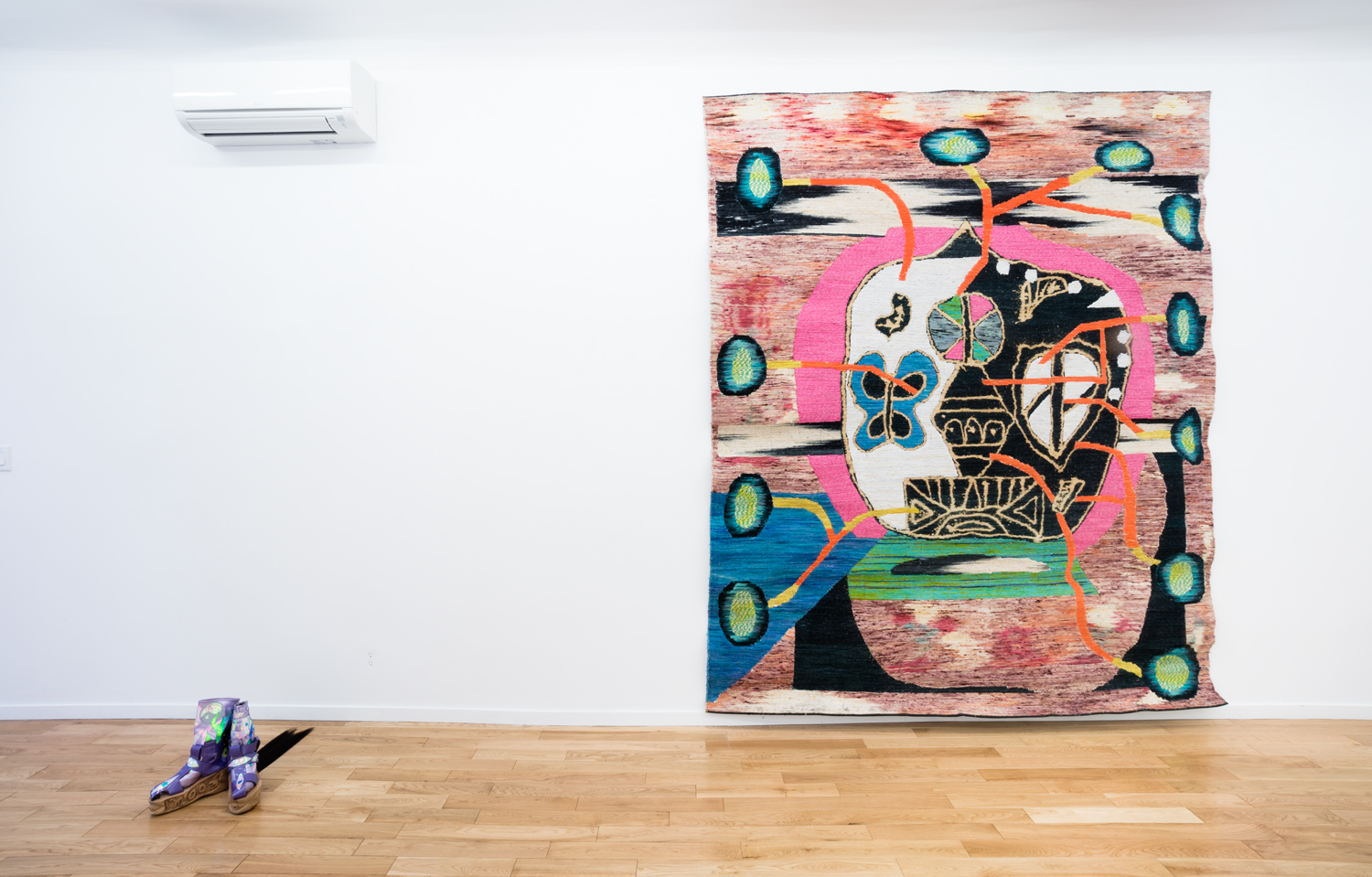
From left to right: Zadie Xa’s “We Came Over Water” (2017); and Yann Gerstberger’s “Swiss Swatchin” (2017).
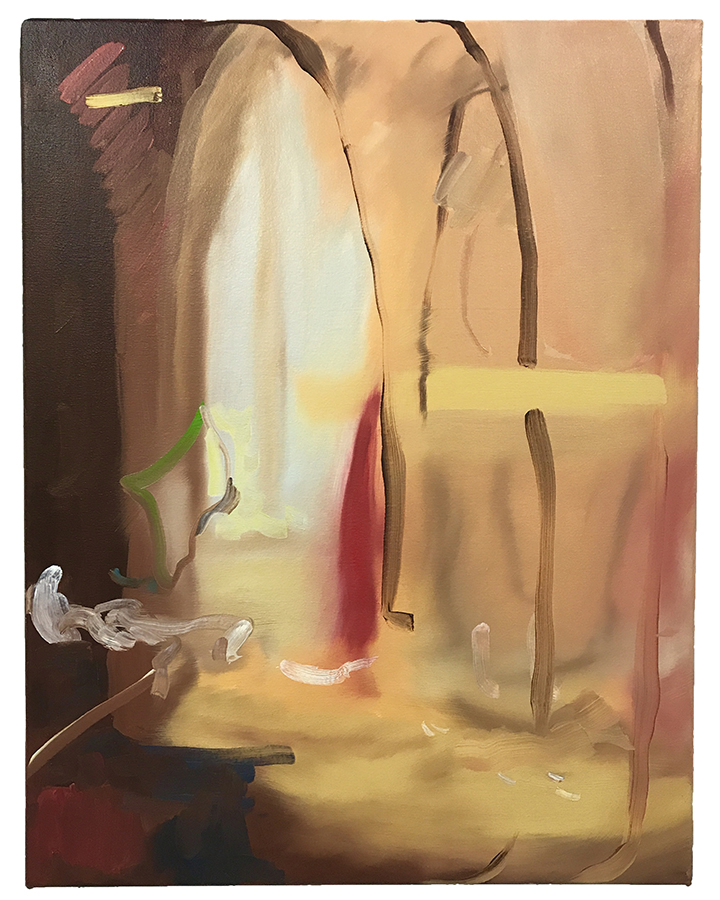
Heather Guertin
Bell’s Studio, 2017
Oil on canvas
68.58 x 53.34 cm (27 x 21 inches)
on view after the performance

From left to right: Yann Gerstberger’s “Swiss Swatchin” (2017) and Beatriz Santiago Muñoz’s “Ojos para mis enemigos” (2013)
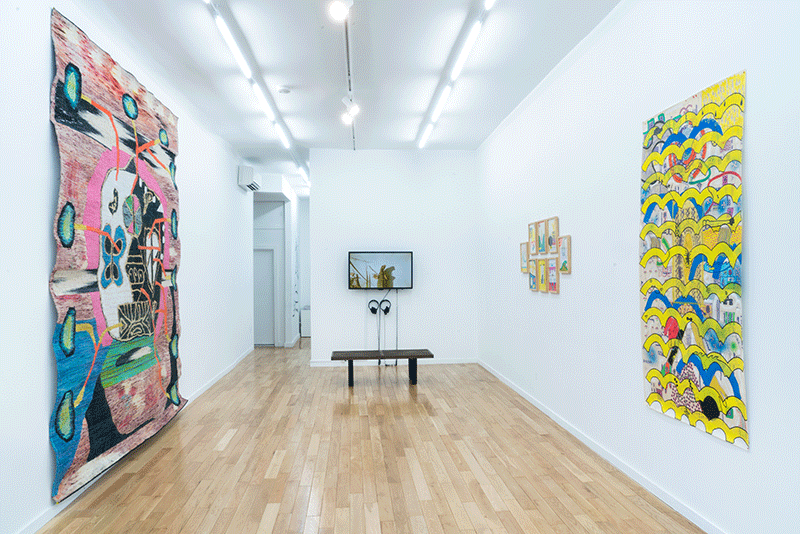
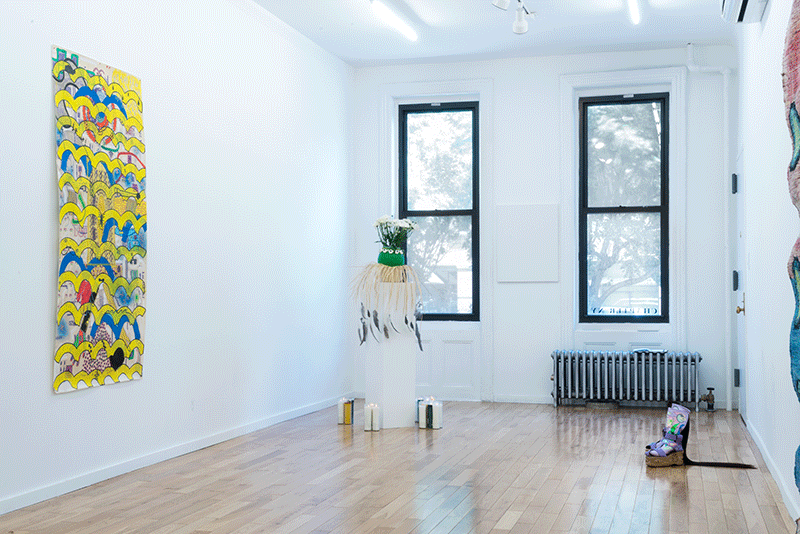
From left to right: Ramiro Chaves, Michael Linares and Zadie Xa
Heather Guertin
Bell’s Studio, 2017
performance [excerpt]